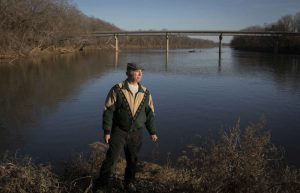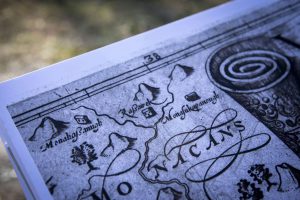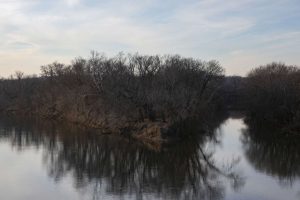MARCH 16, 2022

Kenneth Branham, chief of the Monacan Indian Nation, stands near the confluence of the James and Rivanna rivers where the town of Rassawek once stood.
A four-year battle between a Native American tribe and a Virginia water authority has ended after both parties agreed on a new location for water facilities, the tribe announced Wednesday.
The James River Water Authority will use an alternative route for its pumping station and pipeline project, which originally would have destroyed much of a site believed to be the Monacan Indian Nation’s historic capital of Rassawek, including a burial ground there. In exchange, the tribe will end its long-standing opposition to the project.
The water authority has also agreed to facilitate a transfer of land to the tribe, attorneys for the tribe said.
“This fight has been long and hard, but we are filled with joy to see Rassawek preserved and our ancestors respected,” tribal Chief Kenneth Branham said in a virtual news conference.
Sen. Tim Kaine (D-Va.), who has supported the Monacans’ fight, said in a statement that the site was a “one-of-a-kind Virginia historic treasure” and that he is glad the parties were able to find a resolution.
The water intake and pump station project, an initiative of Fluvanna and Louisa counties, was originally planned for a peninsula of land where the James and Rivanna rivers meet, about 45 miles west of Richmond. The project was announced in 2017 without consulting the Monacans, according to one of the tribe’s attorneys, Greg Werkheiser of Cultural Heritage Partners.
At the time of European settlement in the early 1600s, the Monacans numbered about 10,000 people living across the piedmont and mountains of what is now Virginia, according to the nation’s website. They spoke a different language from the more coastal Powhatans, the tribe that first had contact with the English at the Jamestown settlement, and they avoided European contact for years.

Attorney Greg Werkheiser holds a replica of John Smith’s map showing the Monacan town of Rassawek at the confluence of the James and Rivanna rivers. – Julia Rendleman/TWP
Still, in 1612, when Capt. John Smith published a map of his ventures up the James River, it included the locations of five Monacan villages, including the “chiefest town” of Rassawek, a major trading town.
As White settlers pushed west, the Monacans were forced off their land and dispersed to areas now occupied by North Carolina, Tennessee and perhaps even Canada.
Beginning in the 1880s, Smithsonian archaeologists have found evidence of “extensive burial grounds,” according to Werkheiser. Carbon dating and other methods of investigation have shown the Monacans’ presence at Rassawek for more than 4,000 years, according to the tribe.
When the current Monacans learned of the water authority’s project, it had already gone through the Army Corps of Engineers’ permitting process, and they initially went to Cultural Heritage Partners seeking help to care for artifacts and ancestral remains that might be disturbed. Once it became apparent other sites for the water project were possible, the permit was shelved, and the process was opened to public comment. More than 12,000 individuals and organizations spoke out against the project.
In 2020, the National Trust for Historic Preservation named Rassawek one of the most endangered historic sites in the country.
The project will now relocate a couple of miles upstream to an alternative route that Branham said the tribe pointed out to the water authority.
Though Native American tribes in Virginia were among the first Indigenous peoples to meet English settlers, their descendants have been among the last to receive federal recognition. This is largely a legacy of Walter Plecker, a white supremacist who for decades ran the commonwealth’s Bureau of Vital Statistics and pushed the Racial Integrity Act of 1924. The act banned interracial marriage and forced all births in the state to be classified with one of two designations, “White” or “Colored.”
This “paper genocide,” as it is sometimes called, effectively erased Native Americans from Virginia records.
Branham, who has spent most of his life in Virginia’s Amherst County, was moved to tears when describing the challenges his mother faced while trying to register her four children for public school in the early 1960s. Although the siblings all had the same mother and father, each had a different racial designation, including “Mixed Indian,” “Negro” and “Issue,” Branham said. (“Issue” or “Free Issue” was an antiquated designation for descendants of enslaved people who were freed before the Civil War.)
Once they began going to school, the siblings, who appeared to be White to their classmates, made friends. But a few weeks later, the other kids suddenly stopped speaking to them. When Branham asked why, a classmate told him his parents had learned at church that the Branham kids were “Issue.”
Decades after Plecker’s death, missing and altered birth certificates made it harder for descendants of Virginia’s Indigenous people to get federal recognition, even with an abundance of other evidence. Six Virginia tribes, including the Monacans, finally won federal recognition in 2018.
About 500 Monacans live in Amherst County, including Branham, and there are about 2,100 total members of the tribe.

The confluence of the James and Rivanna rivers is where the Monacan town of Rassawek once stood. – Julia Rendleman/TWP
Werkheiser and his co-counsel and wife, Marion Werkheiser, said they would soon turn to the complicated process of returning Rassawek, and access to it, to the Monacans. Though the water authority has agreed to transfer its parcel of the site to the Monacans, Marion Werkheiser said there are multiple owners of the entire site, whom they would begin conversations with about tribal access, stewardship and eventual ownership.
“It’s a sacred site to us. We have no plans for economic development whatsoever,” Branham said. “You can stand there and look back at history.”
He just wanted to be sure the Monacans would “never have to fight this fight again,” he said.
Courtesy/Source: Washington Post










































































































